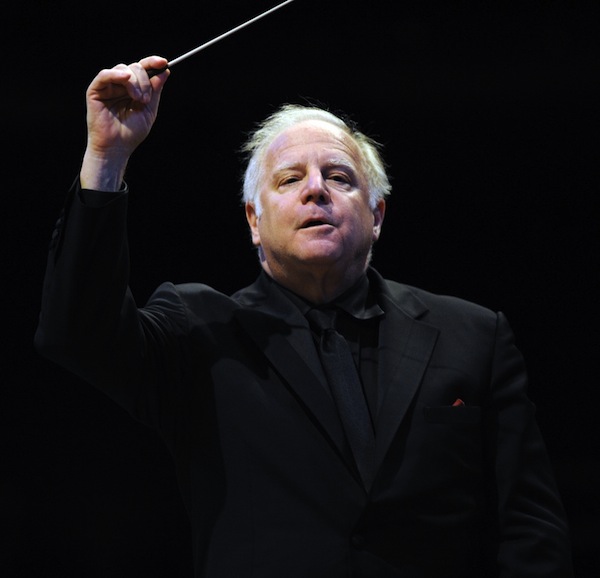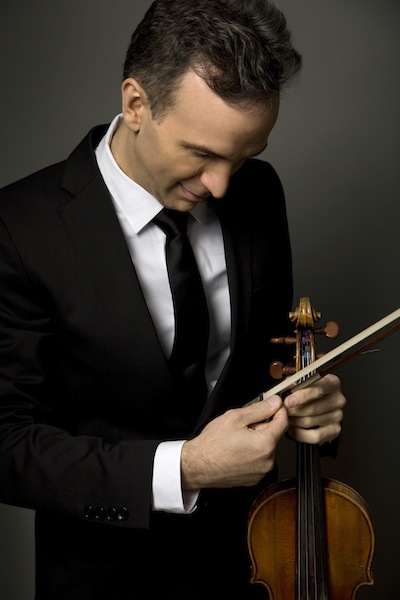French orchestra’s performance très bon at Kravis Center

Leonard Slatkin conducted the Orchestre National de Lyon Sunday night at the Kravis Center in West Palm Beach.
French and American flags shared the stage Sunday as the outstanding Orchestre National de Lyon came to the Kravis Center in West Palm Beach.
Led by music director Leonard Slatkin, the orchestra brought a new work by a contemporary French composer, a ground-breaking French classic, a popular American concerto and a barn-dance-themed encore that required the visiting French musicians to repeatedly shout “Yee-haw!”—which they did pretty convincingly, all things considered.
Visiting orchestras from Europe’s second and third cities have been a mixed group, from top-flight ensembles to fourth-tier groups. The Lyon orchestra ranks without question among the first, with nimble, resonant playing in winds and brass and a string sound of its own–unified, tight and honey-edged, but with a transparent texture more refined than the heavy plushness of many of its peers.
The concert opened with a work titled Celephaïs by the contemporary French composer Guillaume Connesson, inspired by a story of a mythical city by the American horror writer H.P. Lovecraft. There was nothing too serious or profound about this lushly scored work, which fell into the tradition of European tone poems of exotic places, such as España or Scheherazade.
The piece grabs attention from the start with a flourish in the winds, and then atmospheric tones in winds and brass give way to smooth, Hollywood-tinged melodies in the violins. Very French in its unblemished surfaces and the rich colors of its orchestration, the piece was perfect for the refined tone of the Lyon orchestra.
Gil Shaham entered the stage for the Barber Violin Concerto. Shaham performed this piece less than four months ago in Miami with the Cleveland Orchestra. While one would think he could find something else to play on his second visit to South Florida this season, it’s clear why he favors this work, his clean, graceful style perfect for expressing the concerto’s pristine sensibility.
He played the opening in a brisk manner, emphasizing the dissonant tones with the violins. He nailed the runs with which the movement abounds, his technical mastery allowing him to dispatch rapid notes in whatever manner required, from loud and climactic to ghostly and glassy. Throughout the movement, but particularly in the piquant second theme, he played with the clarity, lightness and grace with which he might play a Mozart concerto.
In the Andante, he drew heavier, more sonorous tones from his instrument in solemn dialogues with the orchestra. Particularly moving were the final bars of the movement, where he plays a major-key melody on the instrument’s lower strings, expressing hard-won joy that leads to an exultant tutti in the orchestra.
In the tense perpetual motion of the finale, Shaham achieved dramatic increases in power and intensity with barely perceptible changes of volume and tone. He played in a dry, crisp manner at first, leaving ample room to open up, with his bow arm racing along to the work’s climactic and abrupt ending.
As an encore, the violinist offered the Gavotte and Rondeau from Bach’s Partita No. 3 in E Major, giving a sturdy, courtly account, ornamented with little runs.
Slatkin led a performance of Berlioz’s Symphonie Fantastique that steered clear of the grotesqueness with which some conductors approach this account of an artist’s opium dream, where every crescendo is exaggerated and every forte comes down with a thump. This more classically proportioned account allowed the finely wrought string and wind writing of the opening section to come through, while leaving lots of room for the shock and awe of the nightmarish passages to come.
The waltz of the second movement came off as particularly refined and subdued, emphasizing the nostalgia and sadness of happy times remembered. After holding back the brass players through much of the performance, Slatkin let them loose for the “March to the Scaffold,” its braying chords striking with that much more power. The “Dream of a Witches’ Sabbath” was chilling, with the string section bowing in an unearthly manner that drew eerie sounds from their instruments. Slatkin threw out all restraint at the end, leading the orchestra to a rousing, propulsive last few minutes.
After a standing ovation, Slatkin picked up a microphone and introduced two encores with a reference to another event in the arts taking place that evening: “And the award for best visiting orchestra from France goes to…”
First came more French music, a polished performance of the Intermezzo from Bizet’s Carmen. Then came something unusual, Carmen’s Hoedown, a piece by Felix Slatkin, the conductor’s father, that thrusts themes from Carmen into old-fashioned American western music. The Lyonnaise musicians gamely delivered the country tunes and barn-dance shouts as required.
Posted in Performances
Leave a Comment
Mon Feb 27, 2017
at 2:16 pm
No Comments
